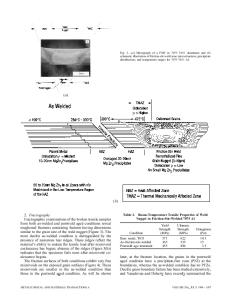The Microstructure, Texture and Mechanical Properties of Friction Stir Welded Aluminum Alloy
- PDF / 4,015,670 Bytes
- 11 Pages / 612 x 792 pts (letter) Page_size
- 10 Downloads / 357 Views
HYSICAL METALLURGY AND HEAT TREATMENT
The Microstructure, Texture and Mechanical Properties of Friction Stir Welded Aluminum Alloy Saliha Gachia, *, Mouloud Aissanib, Thierry Baudinc, Anne.Laure Helbertc, François Brissetc, Sébastien Gautrotd, Marie-Hélène Mathond, Djamel Bradaia, and Fouad Boubenidera aLaboratory
of Materials Physics, Faculty of Physics, University of Sciences and Technology Houari Boumediene, BP 32 El-Alia, Algiers, 16111 Algeria b Research Center in Industrial Technologies CRTI, P.O. Box 64, Cheraga, Algiers, 16014 Algeria cICMMO, SP2M, University Paris-Saclay, UMR-CNRS 8182, Saclay, France d Laboratory Léon Brillouin, CEA-CNRS, CEA/Saclay, France *e-mail: [email protected] Received February 19, 2020; revised July 1, 2020; accepted July 7, 2020
Abstract—The microstructure and texture of 7075-T6 FSW weld with optimal parameters are investigated using optical microscopy, electron back scatter diffraction and neutron diffraction. The mechanical properties are characterized through microhardness, nanoindentation and ultrasonic tests. The friction stir welding is performed at a nominal rotational speed of 1400 rpm and a traverse speed of 60 mm/min. The nugget zone contained fine, equiaxed and fully recrystallized grains. The texture of the base material mainly consisted of Cube and rotated Goss components. However, in the nugget zone, the dominant texture components were B and B among common shear orientations. Elastic modulus was measured by ultrasonic and nanoindentation methods. The ultrasonic method being nondestructive, easy, inexpensive and fast. It is found that a little increase of Young modulus is observed in nugget zone compared to base metal. Keywords: aluminum alloy, FSW, microstructure, texture, microhardness, Young modulus DOI: 10.3103/S1067821220050041
1. INTRODUCTION One of the main materials used for aeronautical applications is the heat treatable 7075 aluminum alloy. It fulfills the main requirements of weight, availability, formability, cost, reliability and maintainability [1]. Due to its excellent strength/weight ratio, this alloy is widely used for the fuselage, the wings and the supporting structure. Unfortunately, fusion welding of this alloy is difficult by conventional techniques due to its copper content which leads to a solidification and liquation cracking in the heat affected zone with a great reduction in mechanical properties within the joint [2]. Friction stir welding (FSW) has been proved to be a powerful joining method and has matured over the last two decades for various metals and alloys. The main advantage of this process is the possibility to weld some materials which are difficult to be welded such as aluminum and its alloy of 7xxx series [2]. In this process, a cylindrical tool composed essentially of a shoulder and profiled pin is rotated and inserted into the adjacent edges of the clamped work pieces to be welded. The frictional heat between the wear resistant tool and the workpieces causes the softening of mate-
rial without reaching melting stage allowin
Data Loading...











